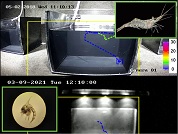Automated tracking of aquatic crustaceans with potential application on the quantification of animals movement
DOI:
https://doi.org/10.25260/EA.23.33.1.0.1920Keywords:
Python, OpenCV, object detection, video tracking, behavioural ecologyAbstract
Here, we present a set of algorithms using the Python programming language, that will allow using a routine for object detection and tracking in experimental videos. We developed a script, under the fundamentals of background subtraction and image thresholding (using the OpenCV package), that makes it possible to track a wide spectrum of animals under different conditions. We have validated this script through testing on semi-terrestrial and aquatic crustacean species and under different experimental scenarios (laboratory and field sampling and using video created under nocturnal and diurnal conditions). The open-source nature of the script allows for flexibility and scalability, so it can be easily customized and is thus transferable to other species/experiments in the context of behavioral ecology. The tracking script is easy customizable and free alternative to commercial video tracking systems and therefore, applicable to a wide variety of both educational and research programs.
References
Antunes, M., and G. Biala. 2012. The novel object recognition memory: neurobiology, test procedure, and its modifications. Cogn Process 13:93-110. https://doi.org/10.1007/s10339-011-0430-z.
Audira, G., N. T. Ngoc Anh, B. T. Ngoc Hieu, N. Malhotra, P. Siregar, O. Villalobos, O. B. Villaflores, T. R. Ger, I. C. Huang, K. H. Chen, and C. D. Hsiao. 2020. Evaluation of the adverse effects of chronic exposure to donepezil (an acetylcholinesterase inhibitor) in adult zebrafish by behavioral and biochemical assessments. Biomolecules 10(9):1340. https://doi.org/10.3390/biom10091340.
Bradski, G. 2000. The OpenCV Library | Dr Dobb’s. URL: drdobbs.com/open-source/the680opencv-library/184404319.
Dell, A. I., J. A. Bender, K. Branson, I. D. Couzin, G. G. de Polavieja, L. Noldus, A. Pérez-Escudero, P. Perona, A. D. Straw, M. Wikelski, and U. Brose. 2014. Automated image-based tracking and its application in ecology. Trends in Ecology and Evolution 29(7):417-428. https://doi.org/10.1016/j.tree.2014.05.004.
Garcia, J. A., V. Sbragaglia, D. Masip, and J. Aguzzi. 2019. Long-term Video Tracking of Cohoused Aquatic Animals: A Case Study of the Daily Locomotor Activity of the Norway Lobster (Nephrops norvegicus). Journal of Visual Experiment 146:e58515. https://doi.org/10.3791/58515.
Iriarte, R., Nuñez, J. D., Spivak, E. D., and C. C. Bas. 2022. Innate response to con- and heterospecific alarm chemicals in juveniles of a freshwater shrimp. Journal of Zoology 318(2):104-113. https://doi.org/10.1111/jzo.13001.
Mahalanobis, P. C. 1936. On the Generalized Distance in StatiJournal of Zoologystics. Proceedings of the National Institute of Science of India 2:49-55.
Noldus, L., J. Spink, and R. Tegelenbosch. 2001. EthoVision: A versatile video tracking system for automation of behavioral experiments. Behavior Research Methods, Instruments and Computers 33(3):398-414. https://doi.org/10.3758/BF03195394.
Nuñez, J. D., V. Sbragaglia, J. A. García, J. B. Company, and J. Aguzzi. 2016. First laboratory insight on the behavioral rhythms of the bathyal crab Geryon longipes. Deep Sea Research I 116:165-173. https://doi.org/10.1016/j.dsr.2016.08.007.
Nuñez, J. D., V. Sbragaglia, P. D. Ribeiro, E. Spivak, and T. A. Luppi. 2021. The magnitude of behavioral responses to artificial light at night depends on the ecological context in a coastal marine ecosystem engineer. Marine Environmental Research 165:105238. https://doi.org/10.1016/j.marenvres.2020.105238.
R Core Team. 2020. A Language and Environment for Statistical Computing. R Foundation for Statistical Computing, Vienna, Austria.
Sbragaglia, V., J. Aguzzi, J. A. García, D. Sarriá, S. Gomariz, C. Costa, P. Menesatti, M. Vilaró, A. Manuel, and F. Sardá. 2013. An automated multi-flume actograph for the study of behavioral rhythms of burrowing organisms. Journal of Experimental Marine Biology and Ecology 446:177-185. https://doi.org/10.1016/j.jembe.2013.05.018.
Thoré, E. S. J., L. Brendonck, and T. Pinceel. 2021. Natural daily patterns in fish behaviour may confound results of ecotoxicological testing. Environmental Pollution 276:116738. https://doi.org/10.1016/j.envpol.2021.116738.
Ushey, K., Allaire J. J., and Y. Tang. 2021. reticulate: Interface to 'Python'. R package version 1.20. URL: cran.r-project.org/package=reticulate.
Schneider, C. A., W. S. Rasband, and K. W. Eliceiri. 2012. NIH Image to ImageJ: 25 years of image analysis. Nature Methods 9:671-675. https://doi.org/10.1038/nmeth.2089.

Downloads
Published
How to Cite
Issue
Section
License
Copyright (c) 2022 Jesús D. Nuñez, Octavio Massone, José A. García

This work is licensed under a Creative Commons Attribution 3.0 Unported License.
Authors retain their rights as follows: 1) by granting the journal the right to its first publication, and 2) by registering the published article with a Creative Commons Attribution License (CC-BY 4.0), which allows authors and third parties to view and use it as long as they clearly mention its origin (citation or reference, including authorship and first publication in this journal). Authors can make other non-exclusive distribution agreements as long as they clearly indicate their origin and are encouraged to widely share and disseminate the published version of their work.


